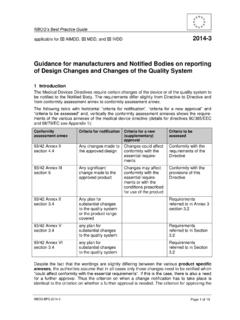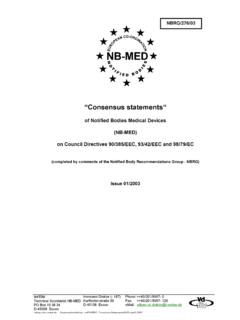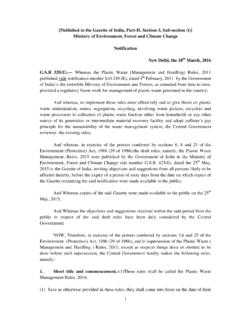Transcription of Companies Act 2013: Beginning of a new era - EY
1 Companies Act 2013 : Beginning of a new eraB| Companies Act 20131 Beginning of a new era | Dear reader,We are delighted to share with you our new publication Companies Act 2013 : Beginning of a new MCA has so far notified and made effective 283 sections, out of total 470 sections of the 2013 Act. The MCA has also issued final rules relating to 19 chapters, covering most of the notified section. To address practical issues, the MCA has also amended Schedule II (regarding depreciation), proposed/issued three orders for removal of practical difficulties and issued certain General Circulars to provide more enactment is a milestone event with far-reaching consequences. Companies should not underestimate the impact of new law.
2 The MCA has addressed some key pain areas for Companies ; however, implementation of the 2013 Act isn t still a hassle free process. Implications and consequences can be severe, if a company fails to take immediate steps to implement the 2013 Act. A case in point is directors and auditors reporting responsibilities with regard to internal financial controls. Though the reporting is needed at year-end, internal financial controls should exist and be operating effectively throughout the year. Another example is the approval required for related party transactions or loans and investments. There are numerous such issues requiring immediate action from compliment the Government of India, especially the MCA, for maintaining a highly consultative approach throughout the process of issuing the 2013 Act and in finalizing the rules.
3 Nonetheless, a large number of interpretative issues and concerns continue to exist, and many of those are discussed in this publication. The most fundamental being the numerous matters where it appears that the final rules may not be in consonance with the 2013 Act. Many of these issues can be addressed through appropriate changes in the rules, schedules and general circulars. A few others may need some amendments to the 2013 Act. We believe that this is not the end of the road, and herein lies a significant opportunity for the MCA to continue engaging with constituents as it has been doing so in the past. Ultimately, all of us would like to see a legislation that is robust, and strikes a sweet spot between business reality and regulatory expect that the MCA/ICAI will come out with a detailed guidance on various issues arising from the 2013 Act and rules.
4 In the meanwhile, this publication expresses our thoughts, perspectives and point of view, on key issues. However, these should not be treated as formal guidance, as there may be different views on these matters and the final say on these issues will be with the courts/regulators. Also, any views or opinions expressed in this publication represent our judgment at the time of publication and may be subject to change, including, but not limited to, due to further actions of the courts or regulators, without notice. We recommend that readers seek appropriate legal/professional advice regarding any specific issues that they new legislation is very vast and therefore we decided to focus on some key topics in respect of which the 2013 Act and rules are notified .
5 These topics are broadly categorized into financial reporting, audit and auditors, related party transactions, loans and investments, corporate social responsibility, corporate governance and mergers, amalgamations and reconstructions. For the purposes of this publication, we have decided to focus more on changes brought by the final rules issued under the 2013 Act, and avoid repeating what was covered in our earlier publications and SEBI, vide Circular dated 17 April 2014, amended Clauses 35B and 49 of the Listing Agreement. The RC49, among other matters, deals with aspects such as related party transactions, independent directors, Audit Committee and vigil mechanism.
6 Though the purpose of RC49 is to align the requirements of the listing agreement with the 2013 Act, there are significant differences, which either impose new requirements or materially alter those contained in the 2013 this publication focuses on requirements of the 2013 Act in certain specific areas; to help listed Companies better understand applicable framework, a brief overview of RC49 is given at the relevant is a matter of great joy to engage with you on this historic change, as we have been doing so traditionally. We hope you will find this publication useful in having a better understanding of the new law. We look forward to your feedback on the publication.
7 Ernst & Young LLP2| Companies Act 2013 Financial Reporting 4 Uniform financial year 4 National Financial Reporting Authority 5 Board report 6 Disclosures required 6 Preparation of board report 6 Disclosures regarding median remuneration 7 Internal financial controls 8 Directors responsibility 8 Auditors responsibility 8 Definition of the term subsidiary 12 Consolidated financial statements 13 Subsidiary financial statements 17 Abridged financial statements 19 Depreciation 20 Declaration and payment of dividend 23 Utilization of securities premium 25 Free reserves 26 Debenture redemption reserve 27Re-opening/revision of accounts 28 Audit and auditors 30 Appointment of auditors 30 Rotation of auditors 32 Eligibility.
8 Qualifications and disqualifications of auditors 36 Independence/prohibited services 39 Reporting responsibilities 41 Internal financial controls 41 Fraud reporting 41 CARO reporting 44 Penalty on auditors 45 Contents3 Beginning of a new era | Related parties transactions 46 Identification of related parties 46 Definition under the 2013 Act 46 Definition under RC49 48 Definition of relative 48 Identification of relevant transactions 51 Approval process 52 Disclosure in the board report 60 Transitional requirements 61 Loans and investments 62 Loans to directors and subsidiaries 62 Loans and investments by company 63 Corporate social responsibility 66 Corporate governance 74 Composition of the board/ non-executive directors 74 Woman director 75 Independent directors 77 Audit Committee 79 Nomination and Remuneration Committee 80 Vigil mechanism 81 Subsidiary Companies 81 Internal audit 82 Mergers, amalgamation and 84reconstruction Glossary 86 4| Companies Act 2013 Uniform financial yearThe definition of term financial year is applicable from 1 April 2014.
9 It requires a company to adopt a uniform accounting year ending 31 March. Companies which are currently following a different financial year need to align with the new requirement within two years. A proviso to the definition states that a company may apply to the NCLT for adoption of different financial year, if it satisfies the following two criteria: Company is a holding or subsidiary of a company incorporated outside India, and Company is required to follow a different financial year for consolidation of its financial statement outside Central Government has still not constituted the NCLT and many provisions relating thereto are not currently notified . Under section 434 of the 2013 Act, certain matters pending with the High Court, District Courts or the CLB, as the case may be, which will be within the jurisdiction of the NCLT, would be transferred to the NCLT from a notified date.
10 Till such time, the courts and the CLB will continue to function. In the absence of NCLT, a company may contact the MCA to seek guidance with regard to which of these authorities they should file an application for adoption of a financial year other than one ending on 31 ReportingPractical issues and perspectivesIn accordance with AS 21, AS 23 and AS 27, a parent company can use financial statements of subsidiaries, associates and joint ventures drawn up to a different reporting date to prepare CFS if it is impractical to have their financial statements prepared up to the same reporting date as the parent. How is the impracticality provision of AS 21, AS 23 and AS 27 impacted by the requirement to have a uniform financial year?















